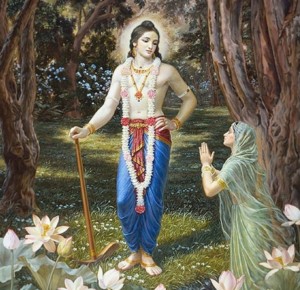 Lord Balarama
Lord Balarama
Once upon a time, Vasudeva, the son of Surasena, just after marrying Devaki, was going home on his chariot with his newly wedded bride. At that time, Kamsa, the son of Ugrasena, in order to please his sister, Devaki, had voluntarily taken the reins of the horses of Vasudeva’s chariot and was driving. While the bride and bridegroom were passing along on the chariot, suddenly a celestial voice vibrated from the sky which announced that the eighth child of Devaki will kill Kamsa. Immediately Kamsa caught hold of Devaki’s hair and was about to kill her with his sword. But Vasudeva intervened and promised that he would present all the children born of Devaki to Kamsa.
When the first child was born, Vasudeva immediately brought the child before Kamsa. Kamsa returned the child to Vasudeva because according to the prophecy, the danger was from the eighth child. But when he learnt from Narada that all the demigods are born in the family of Vrishnis, he became alarmed. He arrested Vasudeva and Devaki and put them behind prison bars. He also decided to kill all the babies who took birth from Devaki and Vasudeva. Thus he killed the first six babies. Lord Balarama appeared as the seventh son in the womb of Devaki.
At this time, Krishna, the Supreme Lord, ordered the appearance of Yogamaya, His internal potency. Yogamaya is the principal potency of the Personality of Godhead. The Supreme Lord ordered her to transfer Lord Balarama from the womb of Devaki to the womb of Rohini. Rohini was one of the wives of Vasudeva and she was residing at the house of Nanda Maharaja and Yashoda in Vrindavana. As ordered by the Supreme Lord, Yogamaya transferred Lord Balarama from the womb of Devaki to the womb of Rohini. On account of being forcibly attracted to the womb of Rohini, He is also known as Sankarshana.
Thus ordered by the Supreme Personality of Godhead, Yogamaya circumambulated the Lord and then appeared within this material world according to His order. When Yogamaya, the supreme power of the supremely powerful Personality of Godhead, transferred Lord Sesha from the womb of Devaki to the womb of Rohini, both Devaki and Rohini were under Yogamaya’s spell, which is called yoga-nidra. When this was done, people thought that Devaki’s seventh pregnancy had been a miscarriage. Thus although Balarama appeared as the son of Devaki, He was transferred to the womb of Rohini to appear as her son.
Meaning of name Balarāma
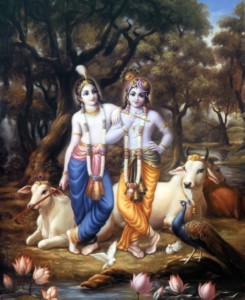 Balarāma – bala means strength and rāma means enjoyment. So Balarāma means who gives you spiritual strength for enjoying eternal blissful life, He is Balarāma.
Balarāma – bala means strength and rāma means enjoyment. So Balarāma means who gives you spiritual strength for enjoying eternal blissful life, He is Balarāma.
If someone calls Lord Rāmacandra by the vibration Hare Rāma, understanding it to mean “O Lord Rāmacandra!” he is quite right. Similarly, if one says that Hare Rāma means “O Śrī Balarāma!” he is also right. Those who are aware of the viṣṇu-tattva do not fight over all these details.
Actually there is no difference between Balarāma and Lord Rāma. It does not matter whether one refers to Balarāma or to Lord Rāmacandra when chanting Hare Rāma, for there is no difference between Them. However, it is offensive to think that Balarāma is superior to Lord Rāmacandra or vice versa. Neophyte devotees do not understand this śāstric conclusion, and consequently they unnecessarily create an offensive situation. In text 154 Śrī Caitanya Mahāprabhu clarified this in a very lucid way: īśvaratve bheda mānile haya aparādha. “It is offensive for one to differentiate between the forms of the Lord.” On the other hand, one should not think that the forms of the Lord are the same as the forms of the demigods. This is certainly offensive.
Balarama’s position
According to expert opinion, Balarāma, as the chief of the original quadruple forms, is also the original Saṅkarṣaṇa. Balarāma, the first expansion of Kṛṣṇa, expands Himself in five forms: (1) Mahā-saṅkarṣaṇa, (2) Kāraṇābdhiśāyī, (3) Garbhodakaśāyī, (4) Kṣīrodakaśāyī, and (5) Śeṣa. These five plenary portions are responsible for both the spiritual and material cosmic manifestations. In these five forms Lord Balarāma assists Lord Kṛṣṇa in His activities. The first four of these forms are responsible for the cosmic manifestations, whereas Śeṣa is responsible for personal service to the Lord. Śeṣa is called Ananta, or unlimited, because He assists the Personality of Godhead in His unlimited expansions by performing an unlimited variety of services. Śrī Balarāma is the servitor Godhead who serves Lord Kṛṣṇa in all affairs of existence and knowledge. Lord Nityānanda Prabhu, who is the same servitor Godhead, Balarāma, performs the same service to Lord Gaurāṅga by constant association.
In all the forms He tastes the transcendental bliss of serving Kṛṣṇa. That same Balarāma is Lord Nityānanda, the companion of Lord Gaurasundara. Lord Gaurasundara (Chaitanya Mahaprabhu) is Sri Krishna Himself. So Balarama came as Nityananda and Krishna came as Chaitanya Mahaprabhu. So Nitai-Gauranga are the incarnations of Balarama and Krishna in Kali yuga!
Sometimes Lord Nityananda serves Lord Caitanya as His guru, sometimes as His friend and sometimes as His servant, just as Lord Balarāma played with Lord Kṛṣṇa in these three different moods in Vraja.
Balarāma is also called guru-tattva or prakāśa tattva. Guru is representative of Balarāma, of Nityānanda, Guru Nityānanda, because He is exhibiting Kṛṣṇa. He is presenting Kṛṣṇa, prakāśa. Just like when there is sunshine you can see everything very correctly. That is called prakāśa. In the darkness everything is covered. At night we cannot see, but during daytime, when there is prakāśa, illumination, then we can see everything. So Nityānanda Prabhu is Balarāma. Balarāma is prakāśa-tattva. He’s manifesting Kṛṣṇa. Balarāma hoila nitāi.
Śrī Kṛṣṇa Caitanya is the Supreme Absolute Personality of Godhead, and next, Nityānanda, or, yes, Nityānanda, is exhibiting Him. When Nityānanda was preaching in Bengal, He first of all delivered the Jagāi and Mādhāi. That was his first business. He showed how to serve Śrī Kṛṣṇa Caitanya Mahāprabhu. Śrī Kṛṣṇa Caitanya means Kṛṣṇa Himself. Śrī-kṛṣṇa-caitanya rādha-kṛṣṇa nahe anya. Rādhā-Kṛṣṇa combined together is Śrī Kṛṣṇa Caitanya. And Nityānanda is exhibiting Kṛṣṇa Caitanyadeva.
One cannot attain the goal of life without the mercy of Balarāma . Śrī Narottama dāsa Ṭhākura therefore says, nitāiyera karuṇā habe, vraje rādhā- kṛṣṇa pābe: when one receives the mercy of Balarāma , Nityānanda, one can attain the lotus feet of Rādhā and Kṛṣṇa very easily. se sambandha nāhi yāra, bṛthā janma gela tāra, vidyā-kule hi karibe tāra… if one has no connection with Nitāi, Balarāma , then even though one is a very learned scholar or jñānī or has taken birth in a very respectable family, these assets will not help him. We must therefore conquer the enemies of Kṛṣṇa consciousness with the strength received from Balarāma.
Balarama’s beauty
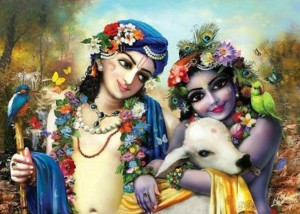 One devotee described the personal beauty of Baladeva as follows “Let me take shelter of the lotus feet of Balarāma, whose beauty is enhanced by the earrings touching His cheeks. His face is decorated with tilaka made from kastūrī [musk], and His broad chest is decorated with a garland of guñjā [small conch shells]. His complexion is as white as an autumn cloud, He wears garments of blue color, and His voice is very grave. His arms are very long, touching His thighs, and He has shown His great strength by killing the Pralamba demon. Let me take shelter of this chivalrous Balarāma .” (Nectar of Devotion)
One devotee described the personal beauty of Baladeva as follows “Let me take shelter of the lotus feet of Balarāma, whose beauty is enhanced by the earrings touching His cheeks. His face is decorated with tilaka made from kastūrī [musk], and His broad chest is decorated with a garland of guñjā [small conch shells]. His complexion is as white as an autumn cloud, He wears garments of blue color, and His voice is very grave. His arms are very long, touching His thighs, and He has shown His great strength by killing the Pralamba demon. Let me take shelter of this chivalrous Balarāma .” (Nectar of Devotion)
Wonderful Pastimes of Lord Balarama
Krishna and Balarama performed many wonderful pastimes in Vrindavana. The sages of Naimisharanya wondered:
krtavan kila karmani saha ramena kesavahatimartyani bhagavan gudhah kapata-manusah
Lord Sri Krishna, the Personality of Godhead, along with Balarama, played like a human being and so masked, He performed many superhuman acts. [Srimad Bhagavatam 1.1.20] These wonderful pastimes and superhuman acts are recorded in the tenth canto of Srimad Bhagavatam. Srila Prabhupada presented the summary study of this tenth canto in the Krishna Book. You can read this book and relish the pastimes of the Supreme Lord. Some of the wonderful pastimes of Lord Balarama are presented here
Killing of Dhenukasura
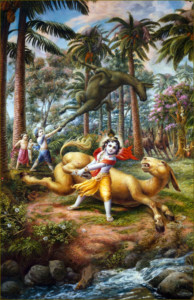 One day the cowherd boys expressed their desire to taste the ripened fruits of palm trees in the Talavana forest, guarded by the demon Dhenukasura who is accompanied by many other demoniac friends, all assuming the forms of asses. Krishna and Balarama wanted to please Their friends and took them all to the Talavana forest. Balarama began to yank the trees with His arms, exhibiting the strength of an elephant, and all the ripe fruits fell down on the ground. Upon hearing the sound of the falling fruits, the demon Dhenukasura, appeared before Balarama and kicked His chest with his hind legs. At first Balarama did not say anything, but with great anger the demon kicked Him again more vehemently. This time Balarama immediately caught hold of the legs of the ass with one hand and, wheeling him around, threw him into the treetops. While he was being wheeled around by Balarama, the demon lost his life. Balarama threw the demon into the biggest palm tree about, and the demon’s body was so heavy that the palm tree fell upon other trees, and several trees fell down. This exhibition of extraordinary strength is not astonishing because Balarama is the Personality of Godhead known as Ananta Sesha Naga, who is holding all the planets on the hoods of His millions of heads.
One day the cowherd boys expressed their desire to taste the ripened fruits of palm trees in the Talavana forest, guarded by the demon Dhenukasura who is accompanied by many other demoniac friends, all assuming the forms of asses. Krishna and Balarama wanted to please Their friends and took them all to the Talavana forest. Balarama began to yank the trees with His arms, exhibiting the strength of an elephant, and all the ripe fruits fell down on the ground. Upon hearing the sound of the falling fruits, the demon Dhenukasura, appeared before Balarama and kicked His chest with his hind legs. At first Balarama did not say anything, but with great anger the demon kicked Him again more vehemently. This time Balarama immediately caught hold of the legs of the ass with one hand and, wheeling him around, threw him into the treetops. While he was being wheeled around by Balarama, the demon lost his life. Balarama threw the demon into the biggest palm tree about, and the demon’s body was so heavy that the palm tree fell upon other trees, and several trees fell down. This exhibition of extraordinary strength is not astonishing because Balarama is the Personality of Godhead known as Ananta Sesha Naga, who is holding all the planets on the hoods of His millions of heads.
Killing of Pralambasura
 Once, while Krishna and Balarama were playing with the cowherd boys a great demon named Pralambasura entered their company assuming the form of a cowherd boy. His intention was to kidnap both Balarama and Krishna. Krishna divided the boys into two teams. Some of them were on the side of Krishna, and some others took the side of Balarama. The arrangement is that the defeated members should carry the victorious members on their backs, as a horse carries its master. The party of Balarama, accompanied by Sridama and Vrishabha, came out victorious. Krishna’s party had to carry them on their backs. Pralambasura had to carry Balarama on his back. He took Balarama far away from the others. Though the demon was very strong and powerful, he could not carry Balarama and suddenly he assumed his real form. Realizing what had happened, Lord Balarama struck the head of the demon with His strong fist, and the demon fell down dead immediately, just like a snake with a smashed head.
Once, while Krishna and Balarama were playing with the cowherd boys a great demon named Pralambasura entered their company assuming the form of a cowherd boy. His intention was to kidnap both Balarama and Krishna. Krishna divided the boys into two teams. Some of them were on the side of Krishna, and some others took the side of Balarama. The arrangement is that the defeated members should carry the victorious members on their backs, as a horse carries its master. The party of Balarama, accompanied by Sridama and Vrishabha, came out victorious. Krishna’s party had to carry them on their backs. Pralambasura had to carry Balarama on his back. He took Balarama far away from the others. Though the demon was very strong and powerful, he could not carry Balarama and suddenly he assumed his real form. Realizing what had happened, Lord Balarama struck the head of the demon with His strong fist, and the demon fell down dead immediately, just like a snake with a smashed head.
Killing of Dvivida (The Gorilla)
Narakasura, a demon whom Lord Krishna killed, had a friend named Dvivida, an ape. Dvivida wanted to avenge the death of his friend. He disturbed the cowherds by setting fire to their homes. He flooded the coastal lands by churning the ocean’s water with his mighty arms. He tore down the trees in the ashramas of great sages. He went to the extent of passing stool and urine on their sacrificial fires. He kidnapped men and women and imprisoned them in mountain caves. When Lord Balarama was in Raivataka Mountain, Dvivida came there and insulted Him. His outrageous activities angered Lord Balarama. He threw a stone at the ape, but Dvivida managed to dodge it. He ridiculed Lord Balarama and tried to attack Him with a tree. Lord Balarama smashed the tree trunk to pieces. Dvivida uprooted all the trees one by one and attacked Lord Balarama, and the Lord simply broke all the trees to pieces. Then the foolish ape started throwing a barrage of stones, and Lord Balarama crushed them all to powder. Dvivida then charged at the Lord and hit Him on the chest with his fists. Lord Balarama kept aside His club and plow weapons & struck Dvivida’s throat and shoulder. The ape vomited blood and fell down dead.
Killing of the demon Balvala
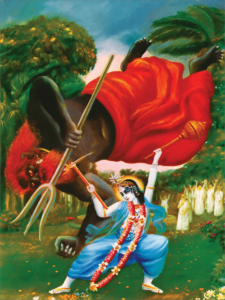 On the request of the sages of Naimisharanya, Lord Balarama decided to kill the demon Balvala, son of Ilvala, who was disturbing the sacrificial performances of the sages. Lord Balarama prepared Himself to meet the demon Balvala. At the time the whole sky became covered with dust and there was a hailstorm. The atmosphere became surcharged with a filthy smell. The mischievous demon Balvala began to shower torrents of stool and urine and other impure substances on the arena of sacrifice. After this, the demon himself appeared with a great trident in his hand. He was a gigantic person, and his black body was like a huge mass of carbon. His hair, his beard and his mustache appeared reddish like copper, and because of his great beard and mustache, his mouth appeared dangerous and fierce. As soon as He saw the demon, Lord Balarama prepared to attack him. He first considered how He could smash the great demon to pieces. Lord Balarama then called for His plow and club, and they immediately appeared before Him. The demon Balvala was flying in the sky, and at the first opportunity Lord Balarama dragged him down with His plow and angrily smashed the demon’s head with His club. Balarama’s striking fractured the demon’s forehead, making blood flow profusely. Screaming loudly, the demon, who had been such a great disturbance to the pious brahmanas, fell to the ground like a great mountain with a red oxide peak being struck and smashed to the ground as if hit by a thunderbolt.
On the request of the sages of Naimisharanya, Lord Balarama decided to kill the demon Balvala, son of Ilvala, who was disturbing the sacrificial performances of the sages. Lord Balarama prepared Himself to meet the demon Balvala. At the time the whole sky became covered with dust and there was a hailstorm. The atmosphere became surcharged with a filthy smell. The mischievous demon Balvala began to shower torrents of stool and urine and other impure substances on the arena of sacrifice. After this, the demon himself appeared with a great trident in his hand. He was a gigantic person, and his black body was like a huge mass of carbon. His hair, his beard and his mustache appeared reddish like copper, and because of his great beard and mustache, his mouth appeared dangerous and fierce. As soon as He saw the demon, Lord Balarama prepared to attack him. He first considered how He could smash the great demon to pieces. Lord Balarama then called for His plow and club, and they immediately appeared before Him. The demon Balvala was flying in the sky, and at the first opportunity Lord Balarama dragged him down with His plow and angrily smashed the demon’s head with His club. Balarama’s striking fractured the demon’s forehead, making blood flow profusely. Screaming loudly, the demon, who had been such a great disturbance to the pious brahmanas, fell to the ground like a great mountain with a red oxide peak being struck and smashed to the ground as if hit by a thunderbolt.
Some of the other wonderful pastimes of Lord Balarama:
- Chastising Yamuna devi when she did not gave way.
- Chastising Kauravas when they had captured Samba.
- Marrying Revati.
- Killing of Romaharshana for not representing Vyasdev properly.
- Pilgrimage at various sacred places of India.

